Did you know that in Indian weddings, there is a tradition of applying mehendi? I know that you may be aware of this tradition, however, do you also know that the groom’s initials are skillfully hidden in it? This tradition of mehendi or henna is a different love story altogether.
But what we understand through this example is of significance. It reflects the use of art at every stage of Indian weddings, whether Haldi, Mehendi, Phere, Mandap decoration or the invitations to be sent out to guests.
The special thing about Indian weddings is that they are held grandly. Marriages in India are a confluence of tradition, rituals, and art. Beginning from pre-wedding rituals to tying the knot, every aspect is seeped with symbolism which is also reflected in the use of art to display the richness of the traditions and rituals.
Art plays a significant role in Indian weddings, from making the bride and groom’s dream come true to the décor of the venue and mandap, artistic touch is seen. The wedding invitations sent out to guests, decoration of the mandap as per the couple getting married wishes it to be, the attire of both of them, the intricacy and elegance of their jewelry and because we are speaking about Indian weddings, arrangement of flowers is also integral and adds to the overall aesthetic. Hence, proving our point, Indian weddings are the true paragon of art and culture, creating a once-in-a-lifetime experience for all present at the wedding.
This blog, too, aims to create an everlasting experience for you by offering insight into the use of art in all the functions at big fat Indian weddings. So, without further ado let’s get started!
Use of Art in Indian Weddings :Invitations
Have you seen in historical TV shows and movies how a messenger was sent out to invite the guests with a scroll? Right, that kind of scroll was actually used in ancient times, in India. During the rule of kings and queens, in India, such scrolls were sent with a messenger and were also read out by them. It was a common practice then, however, with the advent of technology and modernization, there came a revolution in this field. These days we have modern, printed invitations, not only this, but with the increasing use of social media or mobile phones, in general, there has also been a rise in digital or graphic Indian wedding invitations.
The purpose of tracing this evolution is to highlight that with technical advances, we now have access to more artistic features, anything that one can imagine, can now be turned into art.
When looking at the wedding invitations, we also see the influence of regional art. For instance, cultural motifs and symbols may be used to intensify the theme of the wedding. It plays an immensely significant role in displaying and reflecting the aesthetics and cultural heritage of the region the couple belongs to.
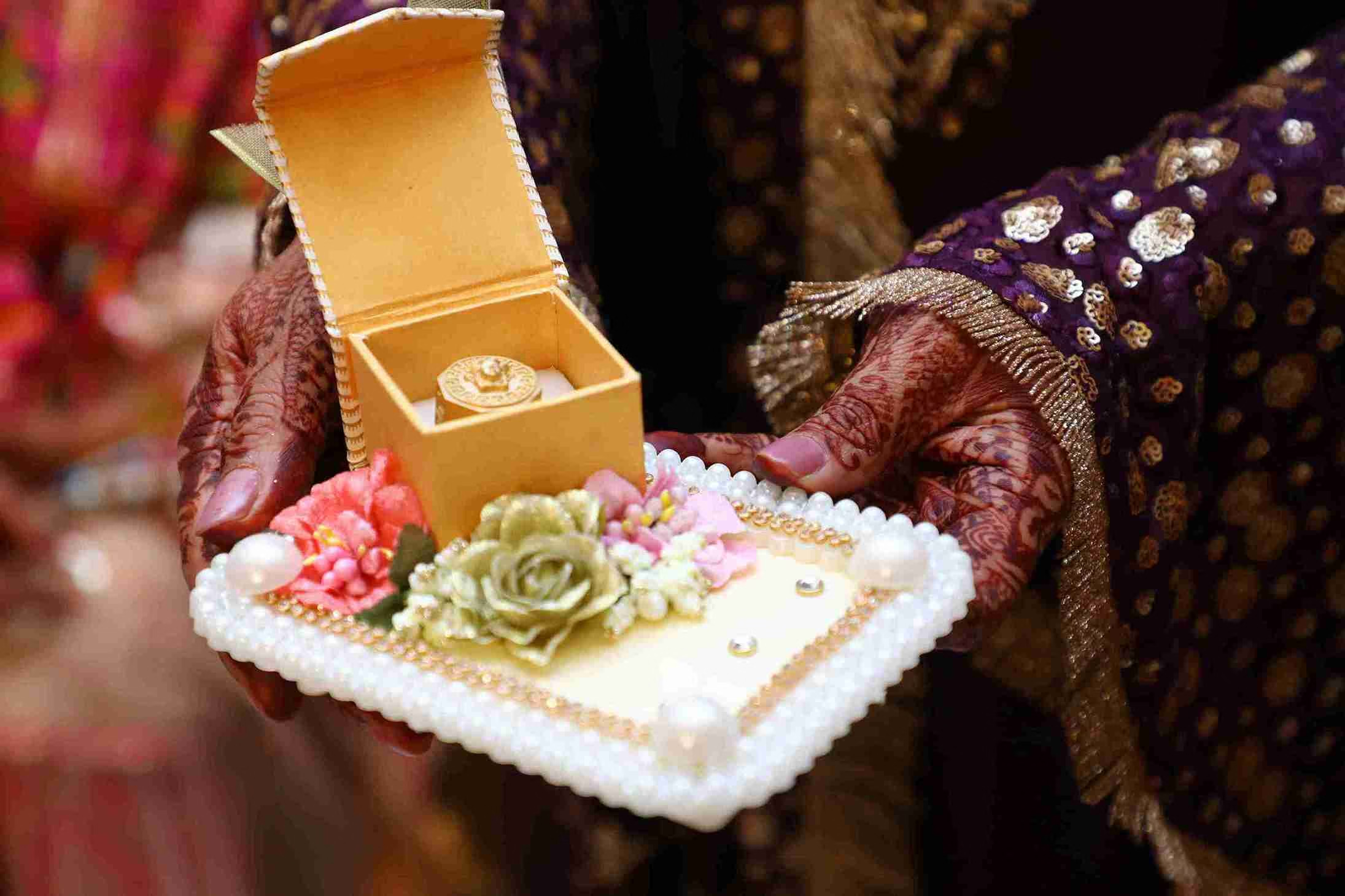
Here’s a breakdown of the different art forms and regions or states it originates from.
The Madhubani art form, Bihar features a mix of geometric elements, figures from Hindu mythology, and natural elements, too. The Indian wedding invitations incorporate Madhubani motifs such as fish, lion, leaves, peacocks, parrots, figures of Radha and Krishna, Laxmi and Vishnu, etc. In short, we can say it employs all kinds of flora and fauna, usually hand-painted. This not only gives it a traditional look but also gives an artistic touch to the invitations.
Moving to the Eastern regions of the country, we have the very popular Pattachitra coming from Odisha and West Bengal. The Pattachitra is often recognized by the fine details that feature mythological narratives. It is a famous as well as traditional art style used in scroll paintings. In today’s times, we find the elements of Pattachitra like Radha and Krishna- symbolizing the beginning of an eternal love between the bride and the groom, the miniature depiction of Baarat (a wedding procession), and also temple-like architectural illustrations. Such a use of elements gives an ethnic stroke to Indian wedding invitations.
Next up we have the Western states Rajasthan and Maharashtra, and the art styles of Phad and Warli originating from the two states respectively. Rajasthani weddings are said to be elaborate and immersive as well as quite grand, however, in contrast to all that grandness, there is the miniature painting. Wedding invitations in Rajasthan often feature the Phad or the Miniature painting style. This style incorporates the use of rich colours like gold, and silver, and adds to the royal Rajputana charm. They often depict wedding processions, giant elephants, royal horses, and also palaces.
In Maharashtra, we come across the Warli art, which is a form of tribal art. It is simple in its approach and is characterized by figures like stickman, and often depicts human life in a particular setting, or the harmonious relation between humans and nature. On the wedding invitations, the Warli art form adds a kind of simplicity and sobriety, and the peace of rural lifestyle that the urban population often misses out on.
One of the well-known art styles in the entire country is the Gond art, even people who know absolutely nothing about art, are aware of the Gond art from Madhya Pradesh. It is a folk art form featuring a complex and intricate pattern, a blend of dots and lines. These dots and lines then create a pattern of different designs, mostly of animals, natural elements, and deities from Hindu myths. This is also usually hand-painted, just like the Madhubani wedding invitations.
As we know India is a diverse country, hence the art styles also differ depending upon the region they come from. This difference in art forms also stems from the geographical, and cultural aspects of the state or region. Coming back to our point of discussion, the next art style that is worth mentioning is the Kalamkari from Andhra Pradesh and Tamil Nadu. The Kalamkari art form is especially known for its use of floral motifs and the compelling narrative that weaves through its patterns.
Next up we have the popular Chikankari and Zardosi art styles from Lucknow, Uttar Pradesh. If you are also someone looking forward to adding the Lucknawi charm and elegance of embroidery to your attires, then Zardosi and Chikankari are the right choices for you! These embroidery techniques feature delicate and soft floral patterns woven with care. On wedding invitations, Zari can be used to enhance elegance and give a sophisticated look.
In today’s times, the use of modern technology such as digital printing, embossing, and gold foiling has enabled the blending of art and aesthetics, especially regional art. Due to this not only the regional art forms mentioned above but also other similar art styles are revived and gain immense popularity.
Such usage of regional art forms in wedding invitations is mostly seen in luxury Indian weddings. The use of cards and paper has now become outdated, instead, there is a rise in the use of sophisticated and subtle designs and patterns. Custom-made and personalized wedding invitations are unique and trending now just like destination weddings!
Mandap Decor at Indian Weddings
The mandap that we see at Indian weddings is a canopy that symbolizes the eternal and sacred bond between the bride and groom. It holds a crucial position in the wedding ceremony. The Mandap is the sacred space where the bride and groom tie the knot, reflecting the union of the two. Hence, the mandap is specially designed to suit their taste and also illustrate their traditions, and culture. It is created with the utmost care, as it requires intricate and complex craftsmanship and skills.
Let us take a look at the traditional mandap designs and how art is used to elevate it from basic to better!
Traditional mandaps are said to draw inspiration from traditional architecture, symbols and motifs from socio-cultural aspects. Mandap designs in Indian weddings typically use temple carvings as their source of reference. Many mandaps these days are designed with intricately carved pillars made out of wood and feature flowers, deities and figures from Hindu mythology. The wood used in the mandap set-up is either sandalwood or teak, this is done to not only maintain the chastity, purity, and sacredness of the rituals but also because it is durable.
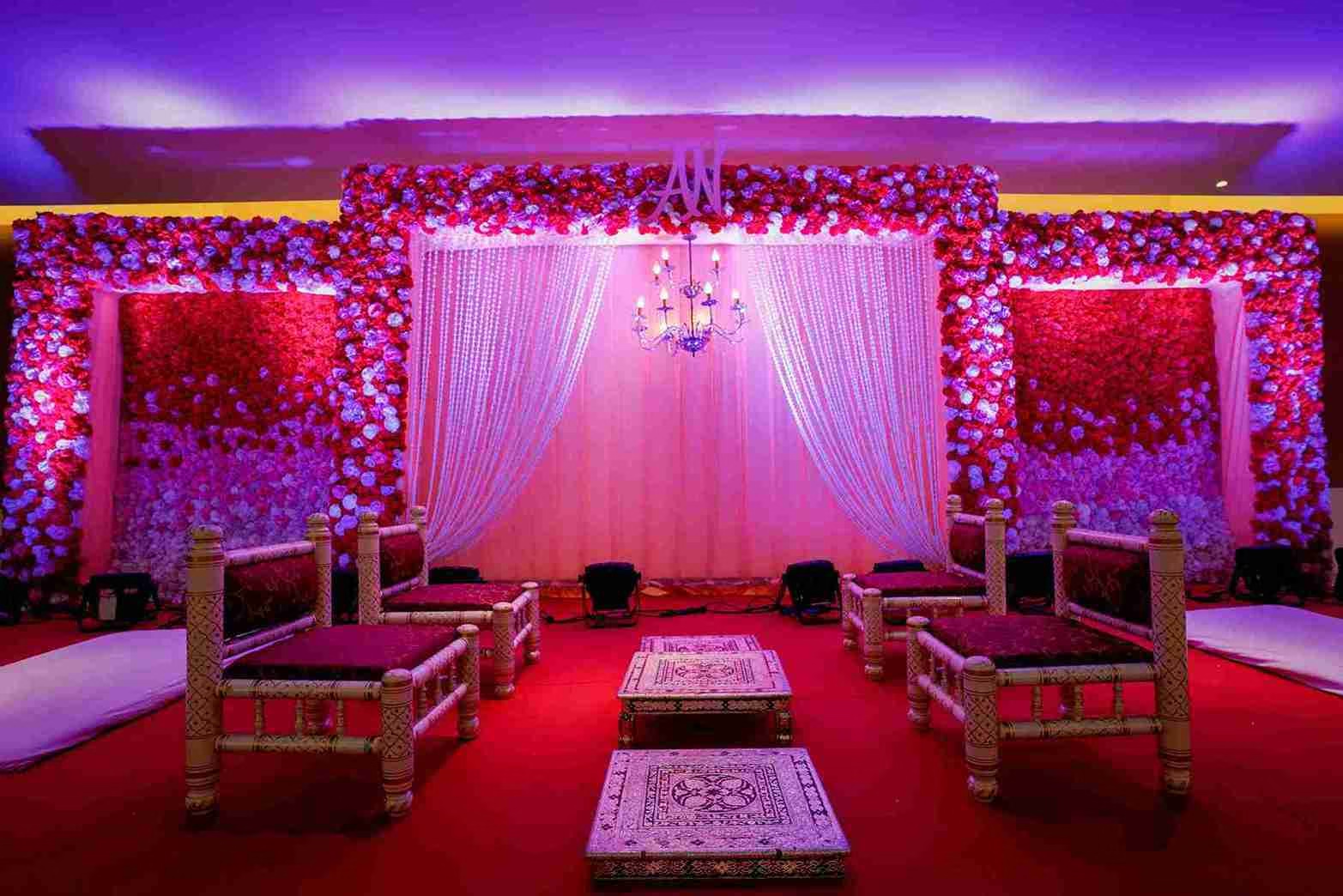
As can be seen in the image above, the mandap or canopy is draped in curtains of silk, and velvet, adored with brocade, embroidery, and in vibrant hues of red, gold, and silver at times, a true hallmark of grand Indian weddings. But the artistic beauty of Indian weddings does not end at this, the flower arrangement also takes an important place in the wedding. Fresh and fragrant flowers such as marigolds, jasmines, roses, etc. all symbolizing the purity, sacred and eternal bond of love, are used to make garlands, and also as chandeliers. Everything creates a beautiful haven of dreams and desires!
One might wonder what role the inspiration from temple architecture plays. Let me break it down for you. So, usually in South Indian weddings, the mandaps mirror the gopurams of the temples, characterized by pillar carvings, lamps made of brass, and a stone base. However, in North Indian weddings the mandap designs reflect the Mughal influence on the architecture of ancient temples. These mandaps often feature dome-like structures, arches, and other Mughal elements like the jaali also known as latticework. The purpose of using temple-like architecture in mandaps is not only to depict the confluence of traditional, ancient elements and aesthetic aspects, but it is also to promote the holiness and sanctity of the institution of marriage, enhancing the allure.
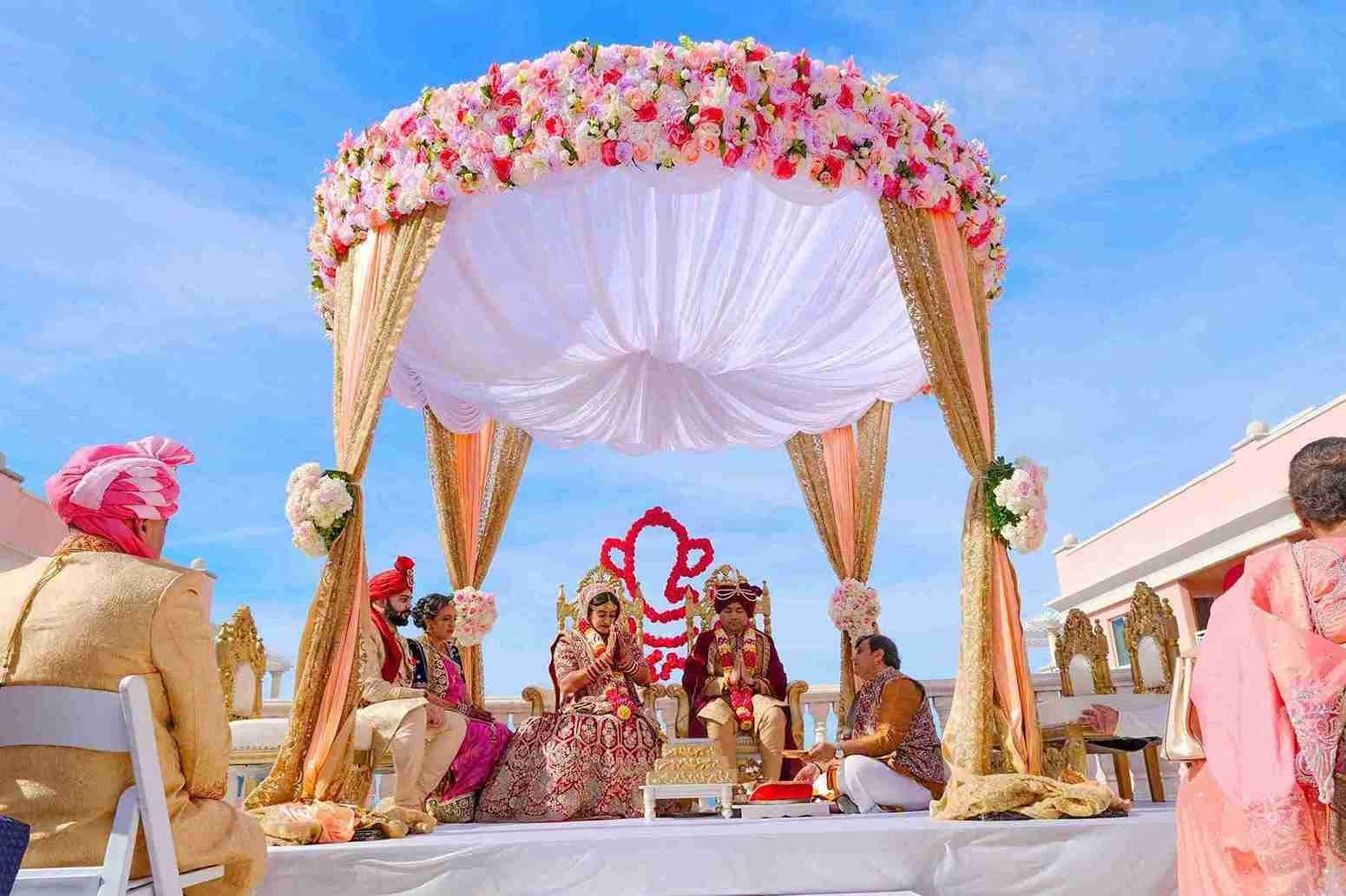
Speaking about the mandaps that adopt a modern twist, these contemporary mandaps assume a more minimalist, subtle, and unique aesthetic. The arrangement of flowers is quite in opposition to the traditional ideas, however, the sacredness is still maintained. Modern mandaps have a floral wall or even floral installations with exotic flowers such as orchids, or peonies. These flowers bring a breath of fresh air, full of love, life, and laughter. Offering the perfect photoshoot spot and romantic charisma that you are looking for!
Looking for a light, delicate, soft, and airy feel at your wedding? Then contemporary mandap is what you would definitely love to take a look at. With a sleek, minimal, and elegant design, contemporary mandaps give the perfect outdoor wedding vibes. The use of metal, and even glass pillars creates a modern impression. Even the draping style differs from the traditional one. The drapes used may be of lighter tones, pastels, or translucent ones to create a dreamy illusion all the while adding a magical touch to the big day of the couple.
No matter what is chosen, traditional or contemporary mandap, art always has a way of making its appearance in the most unique and extraordinary ways at Indian weddings! May it be Mughal arches for gateways and aisles or the floral walls for clicking excellent photographs, mandaps will continue to be a symbol and witness of the beginning of a union. Nowadays, many couples opt for eco-friendly options available out there, and many opt for traditional mandap designs, which is perfectly alright if the purpose is fulfilled and the couple is happy.
End Note
Wrapping it all up, I hope this blog has shed some light on your search. Indian weddings are no longer limited to just being a ceremony full of rituals. Rather they have now become a celebration! Yes, a revelry, like a festival that celebrates art, aesthetics, and culture. Every facet, right from the attire of the bride and groom, to the decor, cuisine served, photography, and every little detail helps in transforming the event into a masterpiece, a dream!
The bridal lehenga or the groom’s sherwani, both showcase the handloom heritage of the nation. Textiles like either Banarasi, Kanjeevaram, or embroidery like Zardozi offer a Bollywood glamour. Even the venue aesthetics, which may range from grand palace-like decorations to minimal and elegant modern arrangements, portray the mastery, skills, and craftsmanship. Such a fusion or mix and match of traditionality and modernity surely leaves the guests in awe!
For further reading, you can visit these useful resources:
Check out our Blog Page on Traditional Indian art.

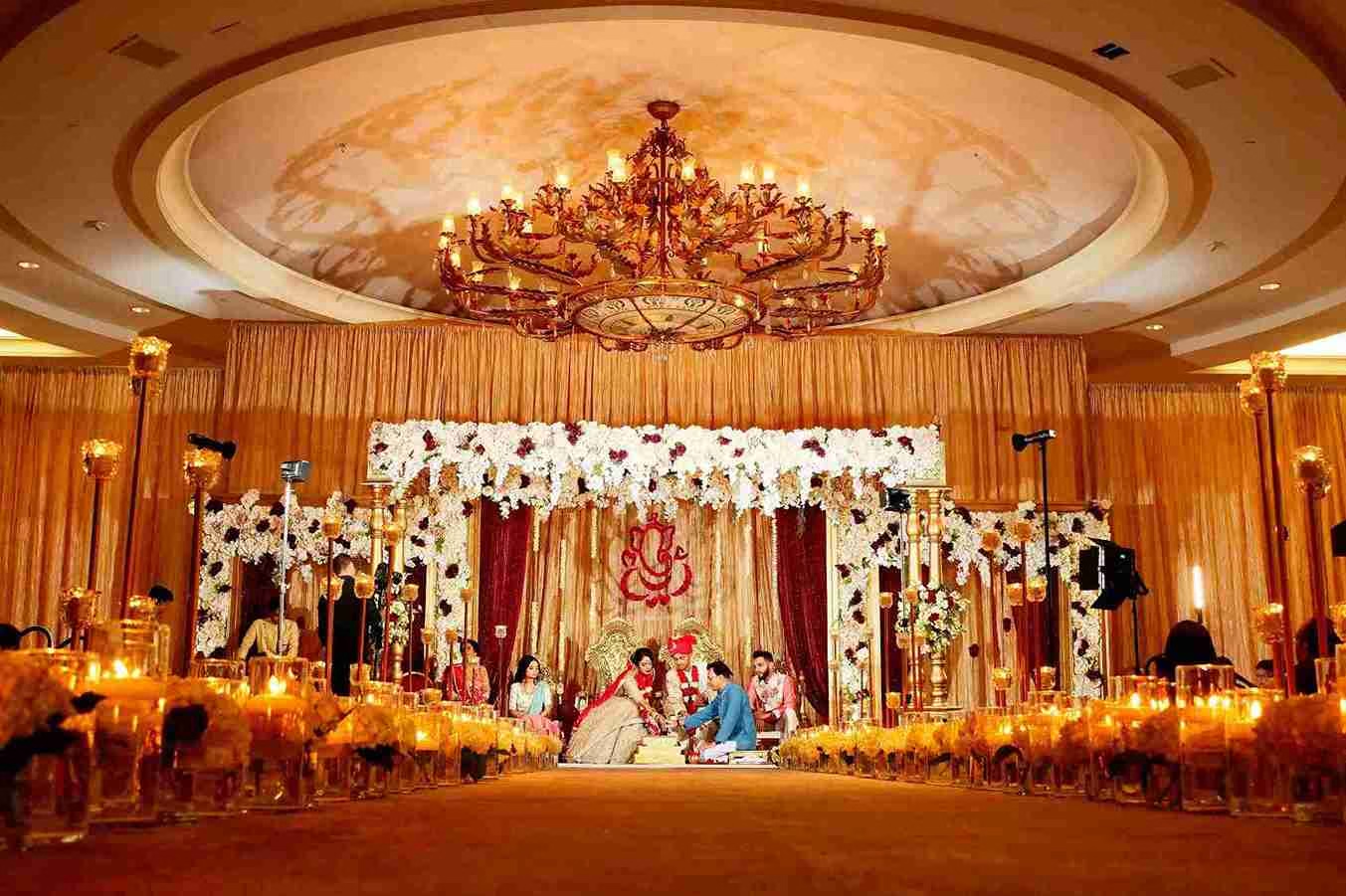
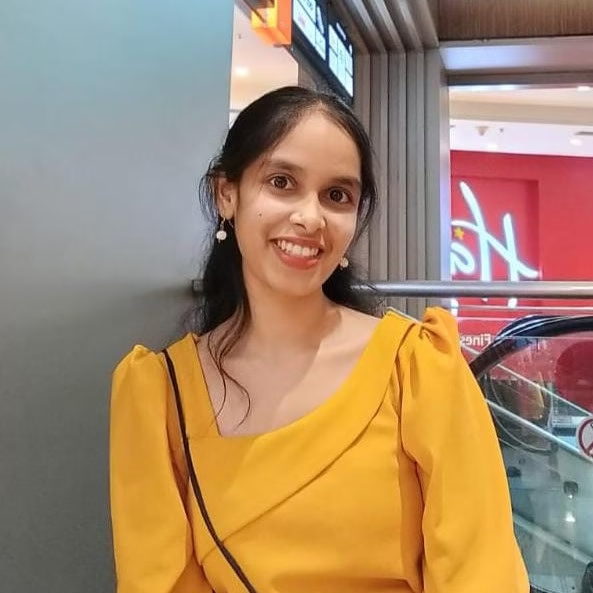
Leave a Reply